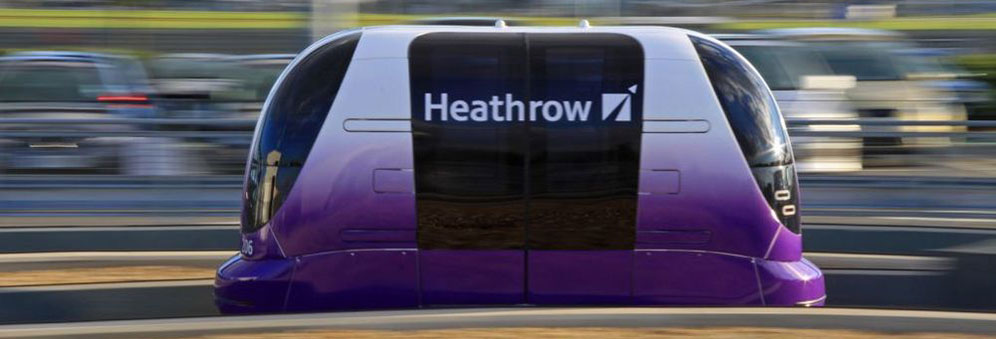Heathrow pods - a new form of personal rapid transit
A new form of fast, reliable and low-cost driverless personal transport is now being used by thousands of passengers every day at Heathrow Airport.
Researchers from the Department of Aerospace Engineering have removed the queuing and inefficiencies associated with bus transfers to Terminal 5 at Heathrow Airport.
Now when passengers park their cars at Terminal 5, they do not have to wait for a bus transfer to the Terminal. Instead, they get straight into a driverless pod. If there isn’t one already waiting, they can call for one. It arrives quickly and takes them to their destination without stopping during the journey.
This revolutionary transit system was designed by researchers at the University of Bristol and commercialised through a spin-off company, now Ultra Global PRT. “There’s an enormous sense of pride for all the staff who were involved in turning this science fiction dream into a reality at Heathrow and demonstrating the best of British innovation” said Fraser Brown, Managing Director of Ultra Global PRT.
Unlike other driverless transit systems, the Heathrow Pod does not need heavy infrastructure and does not involve waiting or stopping during the journey.
The individual pods can take up to four people and their luggage and are designed to run on a separate guideway, enabling a fully automated system. The pods are lightweight and even the infrastructure is lighter and cheaper to build than an equivalent footbridge.
The system also scores high on sustainability as it uses stored energy and has eliminated 50,000 bus journeys a year at Heathrow.
The researchers say that their approach to the project was key to their success - an important part of this was to examine existing PRT concepts and proposals, and to identify the limitations that resulted in them not being exploited.
This analysis showed that the three main components - vehicle, structure and control system - usually lacked adequate design integration. And that the previous designs tried to mimic existing public transport rather than meet the basic requirements such as on-demand availability, non-stop from start to destination, sustainability, low cost and good integration with other forms of transport.
New insights from the Bristol research included:
- the requirement for a separate guideway (away from other forms of transport) so a fully automated system could be authorised as safe
- off-line stations with independent berths to allow an on-demand system with negligible waiting times or queuing
- the ability to use stored energy because of the frequent opportunities to recharge.
This last point led to important changes in basic system design (notably the choice of battery power and station layout), which allowed far more flexibility than the older, standard PRT design approach and enabled greater capacity from the system.
For example, replacing a power pickup by batteries removed 30% from the cost of the guideway infrastructure as well as offering much more flexible operation.
The University’s spin-out company Advanced Transport Systems Ltd was set up in 1995. Now called Ultra Global PRT, this company designed and, since it opened in 2011, runs the world’s first fully operational PRT system at Heathrow Terminal 5.
The Heathrow pods have received an extraordinarily positive response from passengers - the system has the highest satisfaction rating of any passenger service at Terminal 5 - and have attracted intense media interest around the world.
In 2011, John Holland Kaye, then commercial director at BAA (now Heathrow Airport Holdings Ltd), said: “….our excitement for this pioneering British technology is being shared by town planners, architects, other airports, business parks, campuses, retail and residential destinations from the US, Europe, India, Mexico and the UK, who believe that this system could revolutionise transport in urban environments.”
Ultra Global PRT has worldwide interest in applications of the system and has been selected for a major urban transport project in Amritsar, India, to convey pilgrims to the Sikh Golden Temple. The system is designed to take 35% of the daily visitors (or 100,000 passengers) to the Golden Temple from bus and railway stations along a 4.8-mile elevated guideway.
Funders
 Study Aerospace Engineering
Study Aerospace Engineering
Develop solutions to real-world challenges alongside industry partners.
